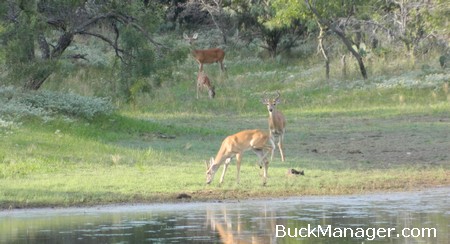Many bow-carrying deer hunters have already headed to the field, but it’s darn tough out there right now for those than plan on whitetail hunting around a feeder. Much like the rain, food plots seem to be hit or miss depending on which part of Texas your located. Those that have been in the woods lately have no doubt discovered that the acorns have fallen. Last check of the game cameras have demonstrated that deer visitation at the feeders has slowed way, way down. But I’m not worried. They are there. Somewhere.
All in all, things are looking really good for Texas deer hunters this year. I’ve corresponded with quite a few property owners within the past couple of months and the overwhelming majority of them say things are looking pretty darn good. Habitat is decent for the time of year, antler quality is there and good numbers of fawns mean good deer hunting seasons to come. State wildlife officials are echoing what landowners have been saying for some time. This season is going to be a good one.

Source: “Statewide population trends remain stable and hunters should expect good numbers of deer year in and year out,” says Alan Cain, TPWD whitetail deer program leader. “I would predict the statewide deer population to be close to or slightly above the long-term average and hover around that 3.6 million deer mark for 2013.”
“One factor hunters should also keep in mind is the good carryover of deer from the 2012 season as harvest was down resulting from heavy acorn and mast crops in several regions of the state,” Cain notes. “For hunters this translates into plenty of opportunities to harvest a deer.” Though the deer population numbers are expected to be good this year, Cain predicts the recent September rains that resulted in a flush of green vegetation may cause bow hunters to rethink their early season hunting strategies as deer may spend less time visiting feeders. A well-traveled game trail may be more productive than hunting at the deer feeder.
Dry conditions in 2011 resulted in a significant decline in fawn production, down to 29 percent for the statewide estimate, a 24 percent departure from the long term average. Fawn crops bounced back in 2012 at 47 percent and Cain anticipates survey results will show a higher fawn crop this year. In fact, Cain is hearing reports from landowners as well as TPWD biologists of fawn production in the 60 to 80 percent range in the Hill Country and similar reports of good fawn production in other areas of the state.
For hunters fawn crops may not be as meaningful since harvest is generally focused on older age class deer, but remember those fawns this year translate into your adult deer several years into the future.
Environmental conditions can play big part in determining hunting season success on yearly basis, but if the hunting outlook in your area does not seem quite as rosy as you’d like then there may be some other factors at play. Never underestimate habitat when it comes to holding and producing whitetail deer. Deer need it because it provides plants to eat and they need it for screening cover. Fawns need it for thermoregulation as well as for concealment from predators. Of course, hunting pressure both on your property and neighboring properties can play a large role too. Consider active deer management to find out more about what’s happening with the deer population in your area, as well improving the deer hunting on your property.